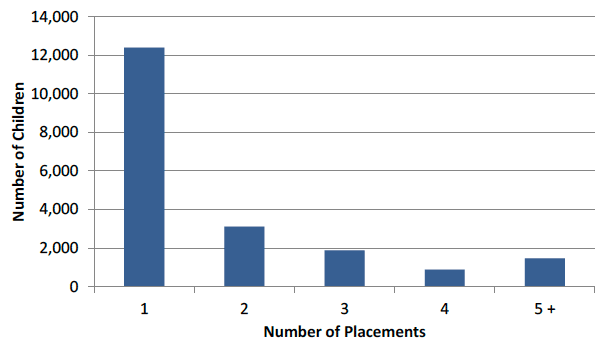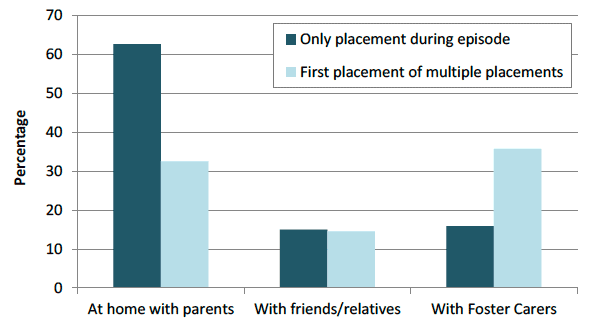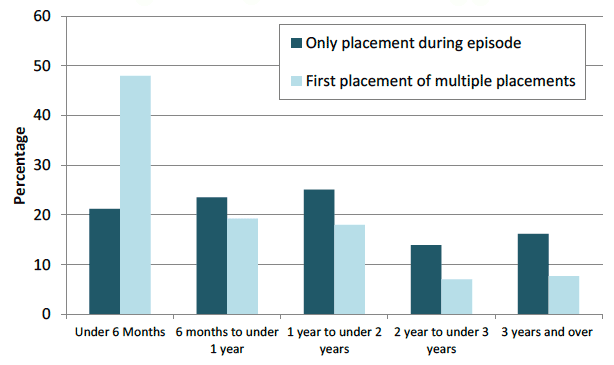Education outcomes for Scotland's looked after children, 2011/12
Leaver destinations and average tariff scores of Scotland's Looked after children who left school during the academic year 2011-12. Also includes analysis from a longitudinal dataset of looked after children between 2008-2012.
This document is part of a collection
Looked after children over time: 2008-09 to 2011-2012

Since individual level information on looked after children was first collected and published in 2008-09, there has been interest in combining each year's data together to analyse the longer term patterns of care experienced by looked after children.
This section looks at findings from a combined dataset from April 2008 to July 2012.
As in previous years, there was not sufficient data to create to a combined dataset, the analyses in this section has not been published previously. As this represents the total individual level data we have on looked after children, there is no historical data to compare it to, so analysis over time is not possible. For more information of the creation and quality assurance of this data, see Background Notes 3.5 and 5.3.
The entire period for which a child is looked after for is called an episode. Within each episode a child may have multiple placements (such as periods in residential care, in foster care, or being looked after at home). This section presents data on children who stopped being looked after (e.g. had an episode end) between 1 April 2008 and 31 July 2012. It looks at the number of placements that children had while being looked after and the length and type of these placements. If a child has ceased to be looked after and then starts to be looked after again during the time period they have been counted individually each time they became looked after.
Number of placements over time
Table 3.1: Number of placements during each episode of being looked after during 2008-2012
Number of Placements |
Number |
% |
Number of Placements |
Number |
% |
|---|---|---|---|---|---|
1 |
12,392 |
62.8 |
6 |
330 |
1.7 |
2 |
3,114 |
15.8 |
7 |
191 |
1.0 |
3 |
1,885 |
9.6 |
8 |
149 |
0.8 |
4 |
881 |
4.5 |
9 |
102 |
0.5 |
5 |
497 |
2.5 |
10 and over |
190 |
1.0 |
Total |
19,731 |
100.0 |
|||
As can be seen in Chart 4, the majority of children had only one placement during an episode of being looked after, with 62.8 per cent of children only having one placement (Table 3.1). Of the children that had more than one placement, the majority of them have 2 or 3 placements during the episode of being looked after.
The number of children tails off as the number of placements increase, with seven per cent of children having 5 or more placements while being looked after.
Chart 4: Number of placements during each episode of being looked after

Placement type over time
Children who remained in the same placement for their whole episode of being looked after show different trends to children who had multiple placements. This section will compare the placement types of children with single placements with the first placement types of children who go on to have multiple placements.
As Chart 5 shows, the two thirds of children with one placement have that placement at home with their parents (62.6 per cent) compared to a third (32.5 per cent) of children who had multiple placements whose first placement was at home. In contrast, children with multiple placements are more than twice as likely to start being looked after in foster care than children with one placement (35.7 per cent compared 15.9 per cent).
Chart 5: Placement type of children who had only one placement and first placement type of children who had multiple placements

Several categories (in local authority home, in voluntary home, in residential school, crisis care, in other community and in other residential) were not included in the chart due to the small numbers but are included in Table 3.2 below.
Table 3.2 : Placement types of children who had one placement and the first placements of children with multiple placements
Placement Type |
Only Placement during episode |
First placement of multiple placements |
||
|---|---|---|---|---|
Number |
% |
Number |
% |
|
At home with parents |
7,760 |
62.6 |
2,382 |
32.5 |
With friends/relatives |
1,855 |
15.0 |
1,067 |
14.5 |
With foster carers |
1,969 |
15.9 |
2,621 |
35.7 |
In other community |
65 |
0.5 |
362 |
4.9 |
In local authority home |
406 |
3.3 |
524 |
7.1 |
In voluntary home |
36 |
0.3 |
43 |
0.6 |
In residential school |
179 |
1.4 |
113 |
1.5 |
In secure accommodation |
28 |
0.2 |
56 |
0.8 |
Crisis care |
9 |
0.1 |
23 |
0.3 |
Other residential |
85 |
0.7 |
148 |
2.0 |
Total |
12,392 |
100 |
7,339 |
100 |
In other community includes children staying with prospective adopters
Placement length over time
When comparing children who have one placement in their episode against the first placement of children who have multiple placements, there are also differences in the lengths of those placements.
Chart 6: Placement length For children who only had one placement and first placement length of children who had multiple placements

Looked after children who had only one placement are more likely to be in this
placement longer than children who go on to have subsequent placements. Nearly half of children (48 per cent) who went on to have multiple placements were in their first placement for 6 months or less, compared to only 21 per cent of children who were looked after in one placement (Chart 6, Table 3.3).
Table 3.3 : Placement lengths of children who had one placement and the first placements of children with multiple placements
Only placement during episode |
First placement of multiple placements |
|||
|---|---|---|---|---|
Placement length |
Number |
% |
Number |
% |
Under 6 Months |
2,632 |
21.2 |
3,522 |
48.0 |
6 months to under 1 year |
2,918 |
23.6 |
1,414 |
19.3 |
1 year to under 2 years |
3,110 |
25.1 |
1,322 |
18.0 |
2 years to under 3 years |
1,724 |
13.9 |
517 |
7.0 |
3 years and over |
2,008 |
16.2 |
564 |
7.7 |
Total |
12,392 |
100 |
7,339 |
100 |
Children who are looked after in one placement are most likely to remain in these placements for either 6 months to under 1 year (24 per cent) or 1 year to under 2 years (25 per cent). A small percentage (eight per cent) of children who are moved to a subsequent placement stay in their first placement for longer than three years. Twice as many children who were looked after in only one remained in this placement for longer than 3 years.
The majority of this section has compared children who have one placement in their episode of being looked after against the first placement of children who have multiple placements. There are also some differences between the children who have one placement in their episode of being looked after and the last placement of children who have multiple placements.
As Table 3.4 shows, children who had multiple placements while being looked after were less likely to have a final placement at home with parents than children with one placement. Around a third (36 per cent) of children with multiple placements had a final placement at home, compared to almost two thirds (63 per cent) of children with one placement in their episode. Conversely, one in ten (10 per cent) children with multiple placements ended their episode with prospective adopters, compared to less than one per cent of the children with one placement in their episode.
Table 3.4: Placement types of children who had one placement and the final placements of children with multiple placements
Placement Type |
Only Placement |
Final placement of multiple placements |
||
|---|---|---|---|---|
Number |
% |
Number |
% |
|
At home with parents |
7,760 |
62.6 |
2,643 |
36 |
With friends/relatives |
1,855 |
15.0 |
1,341 |
18.3 |
With foster carers |
1,969 |
15.9 |
1,270 |
17.3 |
With prospective adopters |
15 |
0.1 |
729 |
9.9 |
In other community |
50 |
0.4 |
184 |
2.5 |
In local authority home |
406 |
3.3 |
512 |
7.0 |
In voluntary home |
36 |
0.3 |
83 |
1.1 |
In residential school |
179 |
1.4 |
280 |
3.8 |
In secure accommodation |
28 |
0.2 |
85 |
1.2 |
Crisis care |
9 |
0.1 |
18 |
0.2 |
Other residential |
85 |
0.7 |
194 |
2.6 |
Total |
12,392 |
100 |
7,339 |
100 |
Contact
Email: Kirsten Hilland
There is a problem
Thanks for your feedback